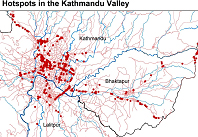
N-MARC's GIS Mapping Enhances Condom Distribution
Challenge
A female dance cabin employee purchases a Panther condom at a non-traditional
outlet outside her place of employment. A man walks into a pharmacy
and purchases 3 Black Cobra condoms late in the evening. A young
couple buys a box of Dhaal condoms at the general store across the
street from their house on a Saturday afternoon. Three different
customers purchase condoms in three distinct ways - at three distinct
places. Understanding their disparate needs and making sure the
product is where it needs to be is one of the goals of the USAID-funded
Nepal Social Marketing and Franchising Project: AIDS, Reproductive
Health, and Child Survival (N-MARC). As part of its effort, N-MARC
has enlisted the services of Mitra Samaj, a Nepali NGO with significant
experience using GIS technology for mapping coverage of health products
and services, to map the areas in Nepal's Kathmandu valley where
high-risk sexual activities are known to take place. This is a crucial
first crucial step in making this goal a reality.
Initiative
The mapping of these 'high-risk' areas used a systematic process
developed over the past four years under USAID/Nepal-funded private
sector health programs. First, N-MARC and Mitra Samaj identified
hot spots, or places where sex negotiation takes place or sexual
activity takes place. From each hot spot they measured a 100 meter
catchments area - or the average distance a person might walk to
get a condom - and connected overlapping hot spots, creating 'hot
zones'. The 'hot zones' were layered over the geographical map of
the Kathmandu Valley. Mitra Samaj then returned to identify condom
selling outlets in 19 randomly selected 'hot zones'; enumerating
all the outlets in these zones, the team developed a clear picture
of relationship between condom-selling outlets and the 'hot spots'.
To gauge access, Mitra Samaj also identified the number of women
working in and around the 'hot spot'.

Results
Through this GIS mapping targeted at quantifying quality of condom
coverage areas and access to condoms for females working in designated
hot zones, the project now possesses a clearer picture of the status
of condom coverage in the capital region. However, beyond the depth
and breadth of the data lies a new story. N-MARC is producing rich
data that illustrates the opportunities in place for the commercial
and social marketing sectors to reach the right consumers, at the
right times, with the right products, leading to a greater and more
accurate measurement of public health impact.
Posted October 2007
Read more about the Nepal Social Marketing and Franchise Project (N-MARC) project